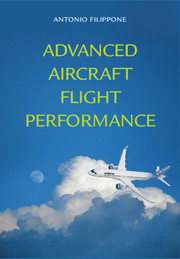Book contents
- Frontmatter
- Contents
- Tables
- Preface
- Nomenclature
- Technology Warning
- 1 Prolegomena
- 2 Aircraft Models
- 3 Weight and Balance Performance
- 4 Aerodynamic Performance
- 5 Engine Performance
- 6 Propeller Performance
- 7 Airplane Trim
- 8 Flight Envelopes
- 9 Take-Off and Field Performance
- 10 Climb Performance
- 11 Descent and Landing Performance
- 12 Cruise Performance
- 13 Manoeuvre Performance
- 14 Thermo-Structural Performance
- 15 Mission Analysis
- 16 Aircraft Noise: Noise Sources
- 17 Aircraft Noise: Propagation
- 18 Aircraft Noise: Flight Trajectories
- 19 Environmental Performance
- 20 Epilogue
- Appendix A Gulfstream G-550
- Appendix B Certified Aircraft Noise Data
- Appendix C Options for the FLIGHT Program
- Index
- References
15 - Mission Analysis
Published online by Cambridge University Press: 05 January 2013
- Frontmatter
- Contents
- Tables
- Preface
- Nomenclature
- Technology Warning
- 1 Prolegomena
- 2 Aircraft Models
- 3 Weight and Balance Performance
- 4 Aerodynamic Performance
- 5 Engine Performance
- 6 Propeller Performance
- 7 Airplane Trim
- 8 Flight Envelopes
- 9 Take-Off and Field Performance
- 10 Climb Performance
- 11 Descent and Landing Performance
- 12 Cruise Performance
- 13 Manoeuvre Performance
- 14 Thermo-Structural Performance
- 15 Mission Analysis
- 16 Aircraft Noise: Noise Sources
- 17 Aircraft Noise: Propagation
- 18 Aircraft Noise: Flight Trajectories
- 19 Environmental Performance
- 20 Epilogue
- Appendix A Gulfstream G-550
- Appendix B Certified Aircraft Noise Data
- Appendix C Options for the FLIGHT Program
- Index
- References
Summary
Overview
Mission analysis refers to the complete set of assumptions regarding the operation of an aircraft and the resulting weight and fuel planning. Several parametric considerations can be added, including mission optimisation, environmental emissions and various commercial ormilitary trade-offs. This chapter illustrates how a detailed mission analysis can be carried out. We start by defining mission scenarios (§ 15.1) and the payload-range charts (§ 15.2). We then make a detailed qualitative and quantitative mission analysis (§ 15.3), including the problems of mission range and mission fuel (§ 15.4), the fuel-reserve policies (§ 15.5) and the short-range performance at MTOW(§ 15.6). In § 15.7 we discuss more advanced problems, such as service with an intermediate stop (§ 15.7.1), tankering (§ 15.7.2) and the point-of-no-return (§ 15.7.3).We proceed with the calculation of the direct operating costs (§ 15.8).We show some case studies: an aircraft selection problem (§ 15.9), a fuel mission planning for a transport aircraft (§ 15.10) and the effect of floats on the payload-range chart of a propeller airplane adapted with floats for water operations (§ 15.11). We close this chapter with an introduction to risk analysis in aircraft performance (§ 15.12).
KEY CONCEPTS: Mission Profiles, Flight Scheduling, Payload-Range Charts, Mission Analysis, Reserve Fuel, Fuel Planning, Tankering, En-Route Stop, Direct Operating Costs, Risk Analysis, Route Selection.
Mission Profiles
A mission profile is a scenario that is required to establish the weight, fuel, payload, range, speed, flight altitude, loiter and any other operations that the aircraft must be able to accomplish. The mission requirements are specific to the type of aircraft.
- Type
- Chapter
- Information
- Advanced Aircraft Flight Performance , pp. 423 - 469Publisher: Cambridge University PressPrint publication year: 2012



